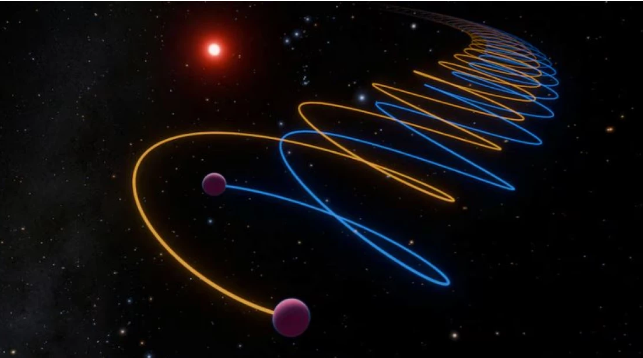In 1995, astronomers made a groundbreaking discovery by identifying the first confirmed brown dwarf, an object that is too small to be a star yet too large to be classified as a planet. However, new research has revealed that this initial discovery was incomplete.
What was thought to be a single brown dwarf is actually two brown dwarfs orbiting each other closely, while also circling a small star. This finding, documented in two recent studies using telescopes in Chile and Hawaii, provides new insight into the object originally named Gliese 229B.
Now recognized as Gliese 229Ba and Gliese 229Bb, the two brown dwarfs form a rare binary system, a gravitationally bound arrangement commonly seen in stars but unusual for brown dwarfs. Gliese 229Ba has a mass 38 times greater than Jupiter, while Gliese 229Bb is 34 times larger than the gas giant. They are located 19 light-years away in the constellation Lepus, relatively close in cosmic terms. The two brown dwarfs orbit each other every 12 days, at a distance only 16 times the separation between Earth and the moon.
Binary brown dwarfs are extremely rare, with only one other known pair orbiting so closely. Brown dwarfs are considered “failed stars,” as they lack the mass to sustain nuclear fusion like true stars but are still more massive than planets.
“A brown dwarf is an object that fills the gap between a planet and a star. They are formally defined as objects that can burn a heavy form of hydrogen, called deuterium, but not the most common basic form of hydrogen,” said Sam Whitebook, a graduate student in Caltech’s division of physics, mathematics and astronomy and lead author of one of the studies, published in the Astrophysical Journal Letters.
“In practice, this means they range in mass from approximately 13 to 81 times the mass of Jupiter. Because they can’t fuse hydrogen, they can’t ignite the fusion channels that power most stars. This causes them to just glow dimly as they cool down,” Whitebook said.
The year 1995 was big for astronomers, with the discovery of the first planet beyond our solar system – an exoplanet – also being announced. Until Gliese 229B’s discovery, the existence of brown dwarfs had only been hypothesized. But there were anomalies about Gliese 229B, particularly after its mass was measured at about 71 times that of Jupiter.
“This didn’t make any sense since an object of that mass would be much brighter than Gliese 229B,” said Caltech astronomer Jerry Xuan, lead author of one of the studies, published in the journal Nature.
“In fact, some models predict that objects with masses above 70 Jupiter masses fuse hydrogen and become stars, which was clearly not happening here.”
The new observations were able to discern two separate brown dwarfs. They orbit a common type of star called a red dwarf with a mass about six-tenths that of our sun. While both brown dwarfs are more massive than Jupiter, their diameter is actually smaller than the gas giant planet because they are more dense.
“We still don’t really know how different brown dwarfs form, and what the transition between a giant planet and a brown dwarf is. The boundary is fuzzy,” Xuan said. “This finding also shows us that brown dwarfs can come in weird configurations that we were not expecting. This goes to show how complex and messy the star formation process is. We should always be open to surprises.”



